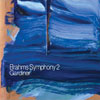Brahms Symphony No. 2
A dramatic, unsettling approach to the Second, but Gardiner can be unyielding
View record and artist detailsRecord and Artist Details
Composer or Director: Franz Schubert, Johannes Brahms
Genre:
Orchestral
Label: Soli Deo Gloria
Magazine Review Date: 5/2009
Media Format: CD or Download
Media Runtime: 0
Mastering:
Stereo
DDD
Catalogue Number: SDG703

Tracks:
| Composition | Artist Credit |
|---|---|
| Symphony No. 2 |
Johannes Brahms, Composer
Johannes Brahms, Composer John Eliot Gardiner, Conductor Orchestre Révolutionnaire et Romantique |
| Alto Rhapsody |
Johannes Brahms, Composer
Johannes Brahms, Composer John Eliot Gardiner, Conductor Monteverdi Choir Nathalie Stutzmann, Contralto (Female alto) Orchestre Révolutionnaire et Romantique |
| Gesang der Geister über den Wassern |
Franz Schubert, Composer
Franz Schubert, Composer John Eliot Gardiner, Conductor Monteverdi Choir Orchestre Révolutionnaire et Romantique |
| Gruppe aus dem Tartarus |
Franz Schubert, Composer
Franz Schubert, Composer John Eliot Gardiner, Conductor Monteverdi Choir Orchestre Révolutionnaire et Romantique |
| An Schwager Kronos |
Franz Schubert, Composer
Franz Schubert, Composer John Eliot Gardiner, Conductor Monteverdi Choir Orchestre Révolutionnaire et Romantique |
Author: Richard Osborne
The approach is well flagged. The choral works that precede the symphony strike a minatory note. I had half expected Gardiner to give us the great a cappella motet Warum ist das Licht gegeben? , Op 74. Also written in Pörtschach in the summer of 1878, it shares the symphony’s key centres and dark-light polarity. But no. We begin in C minor with a soul-grinding account of the Alto Rhapsody. If there is a connection here it is with the tortured trombone-led crisis in the symphony’s first movement development.
More Goethe follows: Schubert’s choral reworking of his own abandoned setting of “Gesang der Geister”. It is a strange piece, closer than the Alto Rhapsody to the symphony’s tragicpastoral mood. “Gruppe aus dem Tartrus”, in a choral and orchestral arrangement by Brahms, hurls us back into hell’s demesne before “An Schwager Kronos” allows us to glimpse the light.
Gardiner quotes Walter Frisch’s report that Brahms “disliked metronomic rigidity and lack of inflection on the one hand, fussy overdetermined expressivity on the other”. In the first movement, he and his period instrumentalists strike exactly that balance. This is characterful music-making, complex and subtle.
What follows is less agreeable. The Adagio, whose opening cello line Brahms marks poco f espressivo, has here an unyielding demeanour. The tempo is the same as Furtwängler’s in his unforgettable 1952 Munich performance with the Berlin Philharmonic but where Furtwängler draws sublimely nuanced song from players who have Brahms’s music deep in their collective memory, Gardiner prefers to lecture us in manly prose.
Furtwängler was a master of transition. Here too Gardiner can be unyielding. The extraordinary cold-light-before-dawn lead back to the finale’s recapitulation, which Tovey extols and which Toscanini rehearsed as if the world depended upon it, goes for next to nothing. Has the dauntlessness that so illumined the first disc in this series proved to be its successor’s undoing?
Discover the world's largest classical music catalogue with Presto Music.

Gramophone Digital Club
- Digital Edition
- Digital Archive
- Reviews Database
- Full website access
From £8.75 / month
Subscribe
Gramophone Full Club
- Print Edition
- Digital Edition
- Digital Archive
- Reviews Database
- Full website access
From £11.00 / month
Subscribe
If you are a library, university or other organisation that would be interested in an institutional subscription to Gramophone please click here for further information.




